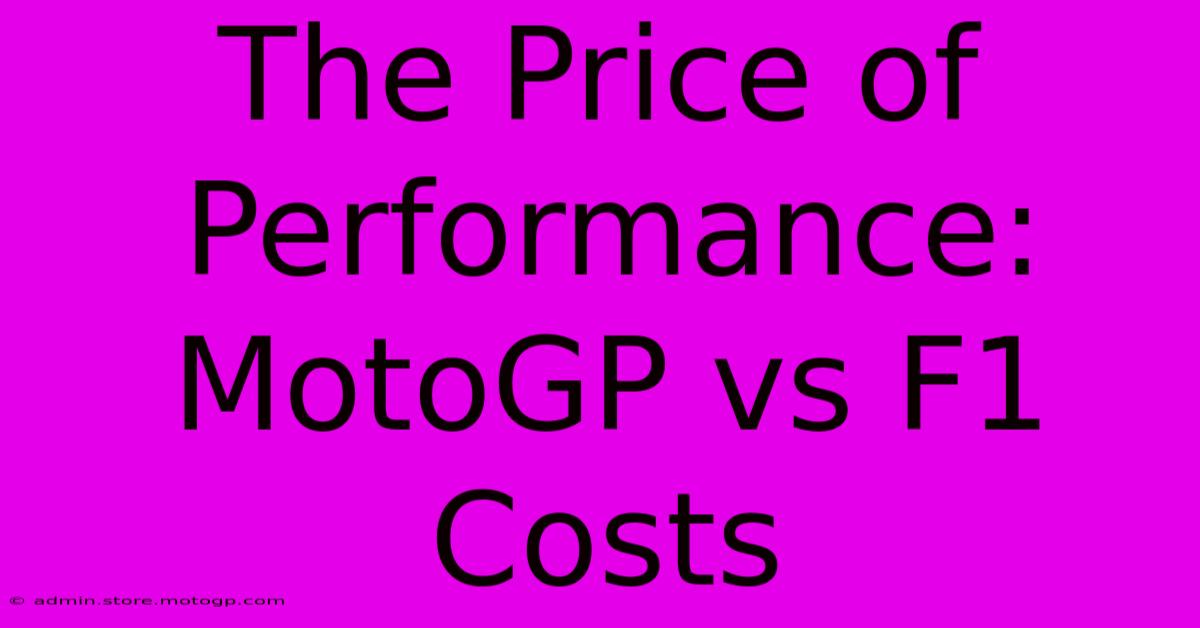The Price Of Performance: MotoGP Vs F1 Costs

Table of Contents
The Price of Performance: MotoGP vs F1 Costs
The roar of the engines, the smell of burning rubber, the nail-biting finishes – Formula 1 and MotoGP are pinnacles of motorsport, captivating millions worldwide. But beyond the glamour and glory lies a stark reality: the staggering cost of competing at the highest level. This article delves into the financial chasm separating these two motorsports giants, exploring the key factors driving their respective price tags.
The F1 Budget Bonanza: A Billion-Dollar Business
Formula 1 is notoriously expensive. Teams routinely operate on budgets exceeding $300 million annually, with top teams potentially spending well over $500 million. This astronomical figure stems from several crucial areas:
1. Research & Development (R&D): The Engine of Innovation (and Expense)
F1 cars are technological marvels, pushing the boundaries of engineering and aerodynamics. The R&D investment is colossal, encompassing:
- Power Unit Development: The complex hybrid power units require massive investment in design, testing, and manufacturing. Each component, from the Internal Combustion Engine (ICE) to the Energy Recovery System (ERS), represents a significant financial commitment.
- Chassis & Aerodynamics: The intricate design and construction of the chassis, along with the relentless pursuit of aerodynamic efficiency, demand substantial resources and expertise. Wind tunnel testing alone can consume millions.
- Simulation & Data Analysis: Modern F1 teams rely heavily on advanced simulation tools and data analysis to optimize car performance. This sophisticated infrastructure contributes significantly to the overall cost.
2. Personnel: A Team of Experts
F1 teams employ hundreds of highly skilled engineers, mechanics, designers, and strategists. Securing and retaining this talent pool requires substantial salaries and benefits packages.
3. Travel & Logistics: A Global Circus
The F1 calendar spans the globe, necessitating extensive travel arrangements for personnel, equipment, and spare parts. The logistical complexities involved add significantly to the operational expenses.
4. Marketing & Sponsorship: Brand Building on a Grand Scale
F1 teams invest heavily in marketing and sponsorship activities to attract corporate partners. These efforts, while crucial for revenue generation, still represent a substantial cost.
MotoGP: A More Accessible (But Still Expensive) Arena
While MotoGP doesn't reach the stratospheric heights of F1 spending, it's still a hugely expensive undertaking. Team budgets typically range from $20 million to $50 million per season, a significant sum but a fraction of F1's expenditure.
1. Motorcycle Development: A Balancing Act
MotoGP bikes, while incredibly sophisticated, are generally less complex than F1 cars. However, the development of engines, chassis, and electronics remains a considerable expense. The constant evolution of technology demands continuous investment.
2. Rider Salaries: Star Power & Performance
Top MotoGP riders command substantial salaries, often comparable to those of mid-level F1 drivers. Securing the services of a championship-caliber rider is a key factor influencing team budgets.
3. Travel & Logistics: A Global Tour
Similar to F1, MotoGP's global calendar necessitates extensive travel and logistical arrangements, contributing significantly to operational costs.
4. Team Personnel: A Smaller, But Highly Skilled Crew
MotoGP teams employ a smaller workforce compared to their F1 counterparts, resulting in lower personnel costs.
The Key Differences: Why the Gap?
The significant cost disparity between F1 and MotoGP boils down to several factors:
- Technology Complexity: F1 cars are significantly more complex and technologically advanced than MotoGP bikes, leading to higher R&D costs.
- Team Size & Structure: F1 teams are substantially larger and more structured than MotoGP teams, resulting in higher personnel expenses.
- Marketing & Sponsorship Landscape: F1 commands higher sponsorship fees and has a broader global reach, allowing teams to generate greater revenue, but also requiring significant marketing investment.
Conclusion: The Price of Victory
Both F1 and MotoGP demand massive financial investments. While MotoGP offers a comparatively more accessible entry point for teams, both championships represent elite-level competition with costs that reflect the relentless pursuit of performance at the highest level. The price of victory, in both these captivating motorsports, remains exceptionally high.

Thank you for visiting our website wich cover about The Price Of Performance: MotoGP Vs F1 Costs. We hope the information provided has been useful to you. Feel free to contact us if you have any questions or need further assistance. See you next time and dont miss to bookmark.
Featured Posts
-
F1 Us Grand Prix Tv Coverage Pre Race Build Up And Analysis
Feb 19, 2025
-
Witness The Fusion F1 Concert Experience
Feb 19, 2025
-
Moto Gp Sprint Races The Key To Success
Feb 19, 2025
-
Cota Parking Find Your Spot In Austin
Feb 19, 2025
-
Moto Gp Sprint Race The Future Of Two Wheel Racing
Feb 19, 2025
